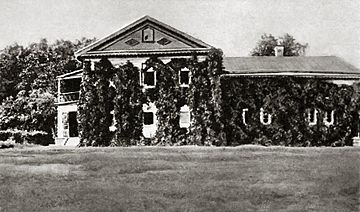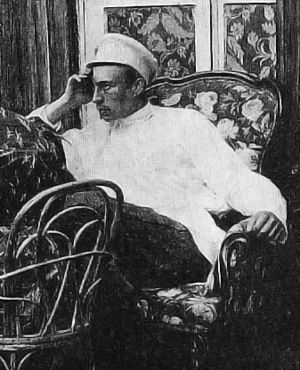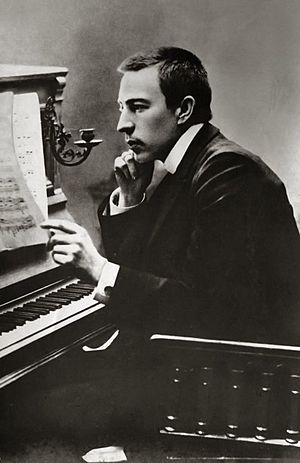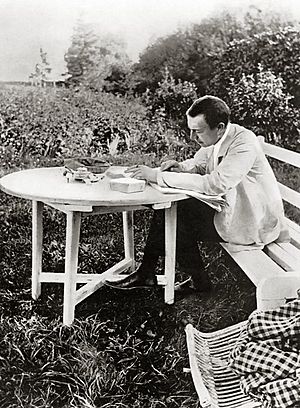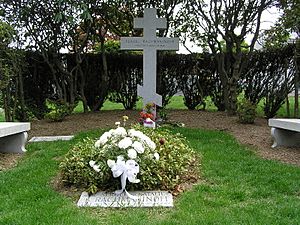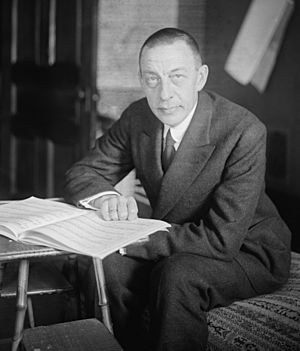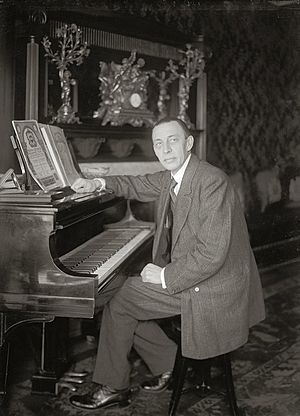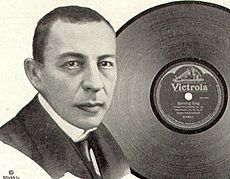Sergei Rachmaninoff facts for kids
Quick facts for kids
Sergei Rachmaninoff
|
|
|---|---|
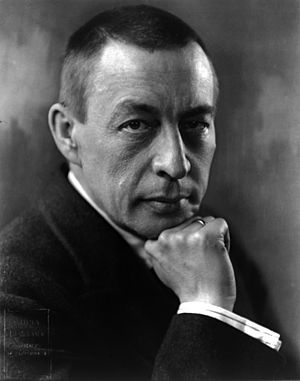
Rachmaninoff in 1921
|
|
| Born | 1 April [O.S. 20 March] 1873 Semyonovo, Staraya Russa, Novgorod Governorate, Russian Empire
|
| Died | 28 March 1943 (aged 69) Beverly Hills, California, U.S.
|
|
Notable work
|
List of compositions |
| Spouse(s) |
Natalia Alexandrovna Satina
(m. 1902) |
| Signature | |
Sergei Rachmaninoff (born April 1, 1873 – died March 28, 1943) was a famous Russian composer, amazing pianist, and conductor. Many people think Rachmaninoff was one of the best pianists of his time. As a composer, he was one of the last great artists of the Romantic period in Russian classical music.
He was inspired by composers like Tchaikovsky and Rimsky-Korsakov. Rachmaninoff's music is known for its beautiful, song-like melodies, strong feelings, and rich sounds from the orchestra. The piano is very important in his music. He used his skills as a performer to show all the amazing things the piano could do.
Sergei Rachmaninoff came from a musical family and started playing the piano when he was four. He studied at the Moscow Conservatory and finished in 1892. By then, he had already written several pieces for piano and orchestra. In 1897, his first symphony did not do well, which made him feel very sad for four years. He didn't compose much during this time. But after getting help, he wrote his very popular Piano Concerto No. 2 in 1901. Over the next sixteen years, he conducted at the Bolshoi Theatre, lived in Germany, and toured the United States.
After the Russian Revolution, Rachmaninoff and his family left Russia. In 1918, they moved to New York City. He earned money by performing as a pianist and conductor, which meant he had less time to compose. Because of this, he only finished six new works between 1918 and 1943. These included the Rhapsody on a Theme of Paganini, Symphony No. 3, and Symphonic Dances. By 1942, his health was getting worse, so he moved to Beverly Hills, California. He became a US citizen a few weeks before he passed away in 1943.
Contents
- Life and Career
- Early Years and Music Lessons: 1873–1885
- Moscow Conservatory and First Compositions: 1885–1894
- First Symphony, Sadness, and Conducting: 1894–1900
- Recovery and New Success: 1900–1906
- Moving to Dresden and First US Tour: 1906–1917
- Leaving Russia and Life in the US: 1917–1925
- Later Compositions and Villa Senar: 1926–1942
- Illness and Death: 1942–43
- Music
- Pianism
- Images for kids
- See also
Life and Career
Early Years and Music Lessons: 1873–1885
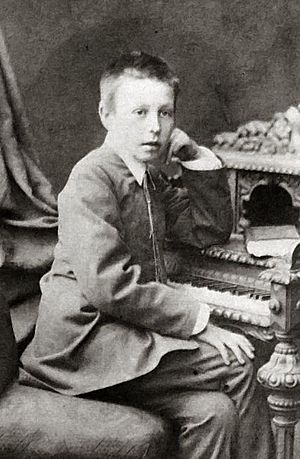
Sergei Rachmaninoff was born on April 1, 1873, into a wealthy family in the Russian Empire. His family had a strong interest in music and the military. His grandfather was a musician, and his father was an army officer and amateur pianist. Sergei's mother also played the piano.
Sergei was born at his family's estate in Semyonovo. When he was four, his family moved to another estate called Oneg. He started piano lessons with his mother at age four. She quickly noticed he could play back songs from memory perfectly. A teacher named Anna Ornatskaya then came to live with the family to give him formal lessons.
Sergei's father lost a lot of money, so the family had to sell their estates. In 1882, they moved to a small apartment in Saint Petersburg. In 1883, when Sergei was 10, Ornatskaya helped him get into the Saint Petersburg Conservatory to study music. Later that year, his sister Sofia died. His father then left the family. His grandmother helped raise the children and took Sergei to church, where he first heard the beautiful church bells and chants that would later inspire his music.
In 1885, Sergei faced another sad loss when his sister Yelena died at 18. She had been an important musical influence on him and had introduced him to Tchaikovsky's music. At the Conservatory, Sergei became a bit lazy and skipped classes. When he failed his exams, his mother asked her nephew, Alexander Siloti, a talented pianist, for advice. Siloti suggested Sergei transfer to the Moscow Conservatory to study with the stricter teacher Nikolai Zverev. Sergei moved in with Zverev in 1885 and stayed for almost four years.
Moscow Conservatory and First Compositions: 1885–1894
At the Moscow Conservatory, Rachmaninoff became friends with another student, Alexander Scriabin. After two years, Sergei won a scholarship. He then studied advanced piano with Siloti, and composition with Sergei Taneyev and Anton Arensky. In 1889, Sergei and Zverev had a disagreement because Zverev didn't want him to focus on composing. Rachmaninoff then moved in with his aunt and uncle, the Satins.
Rachmaninoff spent his summers at the Satins' country estate, Ivanovka. This peaceful place inspired him greatly. He wrote many pieces there, including his Piano Concerto No. 1 in 1891. He also wrote the Youth Symphony and the symphonic poem Prince Rostislav.
In 1892, Rachmaninoff performed his first public concert. He also wrote a one-act opera called Aleko in just seventeen days. It premiered at the Bolshoi Theatre and was a big success. Tchaikovsky himself praised Rachmaninoff for it. Aleko earned him the highest award at the Conservatory, the Great Gold Medal. This made his former teacher Zverev proud, and they became friends again.
After graduating, Rachmaninoff continued to compose. He signed a publishing contract and also gave piano lessons to earn money. In September 1892, he made his public debut as a pianist at an exhibition. There, he played his famous Prelude in C-sharp minor. It became one of his most popular pieces. In 1893, he wrote the tone poem The Rock.
In 1893, Rachmaninoff composed several new pieces. He also published a group of songs. Tchaikovsky agreed to conduct The Rock on a European tour. However, Rachmaninoff was deeply saddened when he learned of Tchaikovsky's death. As a tribute, he quickly wrote his Trio élégiaque No. 2 for piano, violin, and cello. This piece showed his deep sadness for his hero.
First Symphony, Sadness, and Conducting: 1894–1900
After Tchaikovsky's death, Rachmaninoff felt very down and found it hard to compose. He returned to giving piano lessons, which he disliked. In 1895, he finished his Symphony No. 1. He had worked so hard on it that he couldn't compose anything new until he heard it performed.
The premiere of his Symphony No. 1 on March 28, 1897, was a disaster. Critics strongly disliked it. One critic even said it sounded like the "seven plagues of Egypt." Rachmaninoff later said he wasn't bothered by the critics, but he was "deeply distressed" because he didn't like the performance himself. He felt the conductor, Alexander Glazunov, did a poor job. This symphony was not performed again during Rachmaninoff's lifetime.
This bad experience led Rachmaninoff into a deep sadness that lasted three years. He felt like he had "lost the use of his head and hands" and composed almost nothing. To make a living, he gave piano lessons. He got a new opportunity when he was offered a job as an assistant conductor at the Moscow Private Russian Opera. He accepted and conducted his first opera in October 1897.
During this time, Rachmaninoff got engaged to Natalia Satina. However, the church and Natalia's parents were against their marriage because they were cousins. Rachmaninoff's sadness grew worse in late 1899. He tried to compose but couldn't. His aunt even arranged for him to meet the famous writer Leo Tolstoy, hoping it would help, but it didn't.
Recovery and New Success: 1900–1906
By 1900, Rachmaninoff was so critical of himself that composing felt impossible. His aunt suggested he see a doctor, Nikolai Dahl, who used hypnotherapy and supportive therapy. From January to April 1900, Rachmaninoff had daily sessions with Dahl. These sessions helped him sleep better, improved his mood, and brought back his desire to compose.
That summer, Rachmaninoff felt "new musical ideas" coming to him. He finished his Piano Concerto No. 2 in April 1901, dedicating it to Dr. Dahl. The piece was a huge success and was loved by audiences. It won him an award and a prize.
In May 1902, Rachmaninoff married Natalia Satina. Since they were cousins, the church did not approve. So, they had a small ceremony in an army chapel. They received a house at the Ivanovka estate as a wedding gift and went on a honeymoon in Europe. They settled in Moscow, where Rachmaninoff taught music. In 1903, their first daughter, Irina, was born.

In 1904, Rachmaninoff became a conductor at the Bolshoi Theatre for two seasons. He was known for being strict and demanding high standards. He helped improve the orchestra's setup and worked closely with soloists. The theatre also premiered his operas The Miserly Knight and Francesca da Rimini.
During his second season, Rachmaninoff lost interest in his conducting job. There was a lot of social and political unrest in Russia at the time, which made working conditions difficult. In February 1906, he resigned. He then took his family on a trip to Italy, hoping to compose new music.
Moving to Dresden and First US Tour: 1906–1917
Rachmaninoff was unhappy with the political problems in Russia and needed a quiet place to compose. So, in November 1906, he moved his family to Dresden, Germany. They loved Dresden and stayed there until 1909, only returning to Russia for summer breaks. In 1907, he saw a painting called The Isle of the Dead, which inspired his orchestral work of the same name.
Despite sometimes feeling sad, Rachmaninoff began his Symphony No. 2 in 1906. This was twelve years after his first symphony's failure. The premiere of his Symphony No. 2 in 1908 was a great success, and it won him another award.
While in Dresden, Rachmaninoff agreed to perform and conduct in the United States for the 1909–10 concert season. He spent his summers at Ivanovka finishing a new piece for this tour: his Piano Concerto No. 3. He performed 26 times on this tour, 19 as a pianist and 7 as a conductor. One special performance was when he played his Piano Concerto No. 3 with the New York Symphony Orchestra, conducted by Gustav Mahler. Even though the tour made him popular in America, he turned down future offers because it meant too much time away from his family in Russia.
After returning home in 1910, Rachmaninoff became vice president of the Imperial Russian Musical Society. He also finished his choral work Liturgy of St. John Chrysostom, but it was not allowed to be performed in churches. From 1911 to 1913, he was the main conductor of the Philharmonic Society of Moscow, helping to make it more popular.
In 1912, Rachmaninoff took his family to Switzerland and Rome for a holiday. In Rome, he found a poem called The Bells by Edgar Allan Poe, which inspired him to write his choral symphony of the same name. This period of composing ended when his daughters became ill. He conducted The Bells at its first performance in 1913.
In 1914, Rachmaninoff went on a successful concert tour in England. When World War I began, he couldn't join the army because of his job, but he donated money to help with the war. In 1915, he completed another major choral work, All-Night Vigil. It was very well received.
When his friend Alexander Scriabin died in 1915, Rachmaninoff performed a piano recital tour playing Scriabin's music to help his friend's family. This was the first time he publicly played music by other composers. By the end of that year, he finished his 14 Romances, including Vocalise, which became one of his most famous pieces.
Leaving Russia and Life in the US: 1917–1925
When the February Revolution started in 1917, Rachmaninoff performed a piano concert in Moscow to help wounded soldiers. He returned to his Ivanovka estate, but it was taken over by revolutionaries. He left after three weeks, never to return. The estate was later taken by the government.
In June 1917, Rachmaninoff tried to get visas for his family to leave Russia, but it was difficult. After a break in Crimea, his concert in Yalta on September 5, 1917, was his last in Russia. The political tension of the October Revolution made him keep his family safe indoors. He even helped guard his apartment building at night. He finished revising his Piano Concerto No. 1 amidst the chaos.
Rachmaninoff then received an offer to perform in Scandinavia. He quickly accepted, using it as a way to get permission for his family to leave Russia. On December 22, 1917, they left Saint Petersburg by train. They traveled through Finland and arrived in Stockholm, Sweden, on December 24. They carried only small suitcases, with Rachmaninoff bringing some music sketches. In January 1918, they moved to Copenhagen, Denmark.
To earn money, Rachmaninoff, now 44, decided to focus on performing. He practiced a lot to improve his piano skills and learn new pieces. He toured Scandinavia from February to October 1918.
During his tour, Rachmaninoff received offers from the US to conduct or perform many concerts. He was worried about such a big commitment in a new country, but he realized he needed the money. Friends and admirers helped him with travel costs. On November 1, 1918, the Rachmaninoff family sailed from Norway to New York City, arriving eleven days later. Many musicians and fans gathered to welcome him.
Rachmaninoff quickly hired a secretary to help him with American life. He chose Charles Ellis as his booking agent, who arranged 36 performances for the 1918–1919 concert season. His first concert was on December 8 in Rhode Island. He even included his own arrangement of "The Star-Spangled Banner" in the program. He chose to tour with Steinway pianos, and this partnership lasted for the rest of his life.
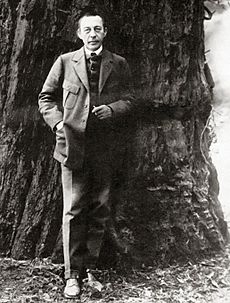
After his first tour, Rachmaninoff took his family to San Francisco to rest. This became his routine: tour, then rest and prepare for the next season. He became financially secure and lived a comfortable life with servants. They tried to keep Russian customs alive in their New York City apartment.
In 1920, Rachmaninoff signed a recording contract with the Victor Talking Machine Company, which gave him much-needed income. In 1921, he bought an apartment in Manhattan overlooking the Hudson River. In 1922, he visited Europe for concerts. He even rented a special railway car with a piano to save time during his busy 1922–1923 concert season. In 1924, he turned down an offer to conduct the Boston Symphony Orchestra.
Later Compositions and Villa Senar: 1926–1942
Rachmaninoff's busy life as a touring performer meant he composed much less. In the 24 years he lived in the US, he finished only six new pieces. He said that by leaving Russia, he "lost his desire to compose." In 1926, after eight years of touring, he took a year off. He finished his Piano Concerto No. 4, which he had started in 1917, and Three Russian Songs.
Rachmaninoff enjoyed the company of other Russian musicians, becoming friends with pianist Vladimir Horowitz in 1928. They supported each other's work. In 1930, Rachmaninoff allowed Italian composer Ottorino Respighi to arrange some of his Études-Tableaux for orchestra.
From 1929 to 1931, Rachmaninoff spent his summers in France, meeting with other Russians who had left their homeland. By 1930, his desire to compose had returned. He bought land in Switzerland near Lake Lucerne and built a home called Villa Senar. He spent his summers there until 1939, often with his daughters and grandchildren. He loved driving his motorboat on the lake. At Villa Senar, he completed Rhapsody on a Theme of Paganini in 1934 and the Symphony No. 3 in 1936.
In October 1932, Rachmaninoff began a very busy concert season. The weak economy in the US meant smaller audiences, and he lost money on his investments. In 1933, he celebrated his sixtieth birthday in Europe with friends. In 1937, he discussed a ballet based on his rhapsody with choreographer Michel Fokine. In 1938, he performed his Piano Concerto No. 2 at a charity concert in London.
The 1939–40 concert season saw Rachmaninoff perform fewer concerts. He toured England, visited his daughter in Paris, and returned to Villa Senar. He injured himself there, but recovered to perform at the Lucerne International Music Festival on August 11, 1939. This was his last concert in Europe. He left Europe on August 23, as World War II was beginning. Rachmaninoff later donated money from many of his concerts to help the Red Army in the war against Nazi Germany.
Back in the US, Rachmaninoff performed with the Philadelphia Orchestra in New York City in late 1939. These concerts celebrated the 30th anniversary of his US debut. He even conducted his Symphony No. 3 and The Bells, his first conducting performance since 1917. After this busy season, he rested on Long Island. During this time, he completed his final composition, the Symphonic Dances. This was his only piece composed entirely while living in the US.
From 1939 to 1942, Rachmaninoff made many recordings, including his Piano Concertos and Symphony No. 3. He was asked to write music for a British film, Dangerous Moonlight, but he declined.
Illness and Death: 1942–43
In early 1942, Rachmaninoff's doctor advised him to move to a warmer place for his health. He had problems with back pain, nerve pain, high blood pressure, and headaches. After his last studio recording sessions in February, he and his wife decided to move to California. In May, they settled in a rented home in Beverly Hills. In June, they bought a house there, living close to his friend, pianist Vladimir Horowitz.
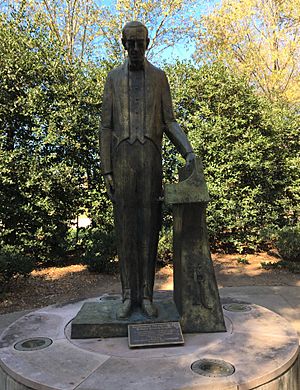
After a performance in July 1942, Rachmaninoff felt very tired and had back pain. He told his doctor that the upcoming 1942–43 concert season would be his last, so he could focus on composing. The tour began on October 12, 1942. Despite his worsening health, he received many good reviews. Rachmaninoff and his wife became American citizens on February 1, 1943.
Later that month, he had a cough and back pain. Doctors thought it was a lung infection. Rachmaninoff decided to continue his tour, but he felt too ill during his travels to Florida. The remaining concerts were canceled, and he returned to California. There, doctors found he had a serious type of cancer called melanoma. His wife took him home, where he was reunited with his daughter Irina.
His last performances as a soloist were on February 11 and 12, 1943, with the Chicago Symphony Orchestra. On February 17, he gave his very last piano recital at the University of Tennessee in Knoxville, Tennessee. He played Chopin's "Funeral Sonata," which was sadly fitting for the occasion.
Rachmaninoff's health quickly got worse in late March 1943. He lost his appetite, had constant pain, and found it hard to breathe. On March 26, he lost consciousness and passed away two days later, just four days before his 70th birthday. His funeral was held at a Russian Orthodox Church in California. Rachmaninoff had wanted to be buried in Moscow, but his American citizenship made that impossible. He was buried at Kensico Cemetery in Valhalla, New York.
In 2015, Russia wanted to move Rachmaninoff's remains back to Russia. However, his family members living in the US disagreed. They said he died in the US after living outside Russia for decades because of political reasons.
Music
Famous Works
Rachmaninoff wrote five pieces for piano and orchestra. These include four concertos: No. 1, No. 2, No. 3, and No. 4. He also wrote the Rhapsody on a Theme of Paganini. The Second and Third Concertos are his most popular.
He also composed many works for orchestra alone. He wrote three symphonies: No. 1, No. 2, and No. 3. These symphonies show how his music changed over time. The Second Symphony has been the most popular. Other orchestral works include his Symphonic Dances and four symphonic poems like The Isle of the Dead.
Since Rachmaninoff was a skilled pianist, he wrote many pieces for solo piano. These include 24 Preludes, like the famous Prelude in C-sharp minor. He also wrote two sets of very challenging Études-Tableaux, which are like "study pictures." Other piano works include Six moments musicaux and Variations on a Theme of Chopin. He also wrote two large and difficult piano sonatas.
Rachmaninoff composed two major choral works without instruments: the Liturgy of St. John Chrysostom and the All-Night Vigil (also called the Vespers). He asked for the fifth movement of All-Night Vigil to be sung at his funeral. Other choral works include the choral symphony and the cantata Spring.
He completed three short operas: Aleko, The Miserly Knight, and Francesca da Rimini. Aleko is still performed and recorded often.
Rachmaninoff wrote less chamber music (music for a small group of instruments). His chamber works include two piano trios (one as a tribute to Tchaikovsky), a Cello Sonata, and Morceaux de salon for violin and piano.
He composed 83 songs for voice and piano, all before he left Russia in 1917. Most of his songs used texts by Russian poets. His most popular song is the wordless Vocalise, which he later arranged for orchestra.
How His Music Sounds
At first, Rachmaninoff's music sounded like Tchaikovsky's. But by the mid-1890s, his own unique style started to appear. His First Symphony had new and powerful features for Russian music at the time. He used flexible rhythms, sweeping melodies, and made sure every musical idea was important. He kept these qualities and made them even better in his later works.
After the bad reception of his first symphony and three years of not composing, Rachmaninoff's style changed a lot. He started writing broad, emotional melodies. His orchestral music became more detailed and varied, with different sounds carefully balanced. His writing became more focused and clear.
Rachmaninoff often used widely spaced chords to create bell-like sounds. You can hear this in many pieces, especially in The Bells symphony, the Second Piano Concerto, and some of his Preludes. He loved Russian Orthodox chants, and many of his melodies were inspired by them. The opening melody of his First Symphony comes from these chants.
Rachmaninoff also often used a short musical idea called the Dies Irae, which is a very old church melody. He was very good at counterpoint (combining different melodies) and fugal writing, thanks to his teacher Taneyev. This skill allowed him to write complex and beautiful music, both in short pieces and long ones. His Third Piano Concerto shows how clever he was with musical structure. Each of his preludes starts with a small musical idea and grows into a powerful, emotional miniature.
His style continued to change even before he left Russia. The harmonies in The Bells (composed in 1913) were very advanced. In his revised First Piano Concerto and his later songs and Études-Tableaux, he focused more on musical "colors" than just pure melody. His style in these pieces was almost like Impressionist painting, matching the poems he used. The Op. 39 Études-Tableaux are some of the most challenging pieces he wrote.
Later in his life, his music became even clearer and more direct. The Variations on a Theme of Corelli (1931) showed a very clear texture, with sharper harmonies and rhythms. This style continued in his last works, like the Piano Concerto No. 4 and the Symphonic Dances. However, some of his most beautiful and nostalgic melodies are found in his Third Symphony and Rhapsody on a Theme of Paganini.
Reputation and Lasting Impact
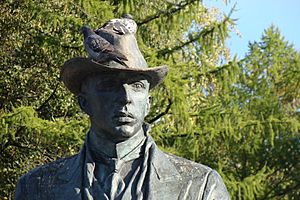
Rachmaninoff's music wasn't always immediately recognized by everyone. For example, a famous music dictionary in 1954 said his music was "boring" and wouldn't last. But a music writer named Harold C. Schonberg called this statement "outrageously snobbish." Today, Rachmaninoff's music is very popular and loved around the world.
The Conservatoire Rachmaninoff in Paris is named after him, as are streets in Russia. In 1986, the Moscow Conservatory named a concert hall after him. There are also statues of Rachmaninoff in Moscow and Veliky Novgorod, Russia. A musical called Preludes (2015) tells the story of Rachmaninoff's struggles with sadness and not being able to compose.
A statue called "Rachmaninoff: The Last Concert" stands in Knoxville, Tennessee, to honor his final concert there. In 2019, a concert in Alexandria, Virginia, featured Rachmaninoff's music. His great-granddaughter, Natalie Wanamaker Javier, spoke at the event, sharing insights about the composer.
Pianism
Rachmaninoff was one of the best pianists of his time, known for his clear and brilliant playing. His performances were precise, had strong rhythm, and he could keep the music clear even in very complex parts. He played music by many composers, including Chopin, Bach, Beethoven, and Liszt.
Two pieces that Rachmaninoff especially admired became very important in his own concerts: Beethoven's Appassionata and Chopin's Funeral March Sonata.
Playing Style
Rachmaninoff had very large hands, which allowed him to play difficult chords easily. His left hand was especially strong. His playing was known for its "definition"—while other pianists might sound blurry, Rachmaninoff's music was always crystal clear. Only a few other pianists of his time had this level of clarity.
Musical Sound
Along with his clear sound, Rachmaninoff's playing had a singing quality, much like a beautiful voice. Because he had a lot of experience with opera, he loved good singing. His recordings show that he could make a musical line "sing," no matter how long the notes or how complex the background music was. His interpretations often told a story. He could create many different "voices" in his playing, like a conversation between instruments. This skill came from his amazing ability to move his fingers and hands independently.
Recordings
When Rachmaninoff first arrived in America, he needed money. In 1919, he recorded some piano pieces for Edison Records. He wanted to approve every recording before it was released, and Edison agreed. However, Edison still released multiple versions, which annoyed Rachmaninoff. Because of this and other technical issues, Rachmaninoff left Edison Records when his contract ended.
In 1920, Rachmaninoff signed a contract with the Victor Talking Machine Company (later RCA Victor). This company was happy to meet his requests and proudly advertised him as a top recording artist. He continued to record for Victor until 1942.
When Rachmaninoff recorded his works, he aimed for perfection, often re-recording pieces until he was completely satisfied. His recordings of Schumann's Carnaval and Chopin's Piano Sonata No. 2 are especially famous. He recorded all four of his piano concertos with the Philadelphia Orchestra. He also recorded his Rhapsody on a Theme of Paganini and conducted the orchestra in recordings of his own Symphony No. 3 and Isle of the Dead.
Rachmaninoff also made many piano rolls from 1919 to 1929. These rolls could be used to play his performances on special pianos.
Images for kids
See also
 In Spanish: Serguéi Rajmáninov para niños
In Spanish: Serguéi Rajmáninov para niños


